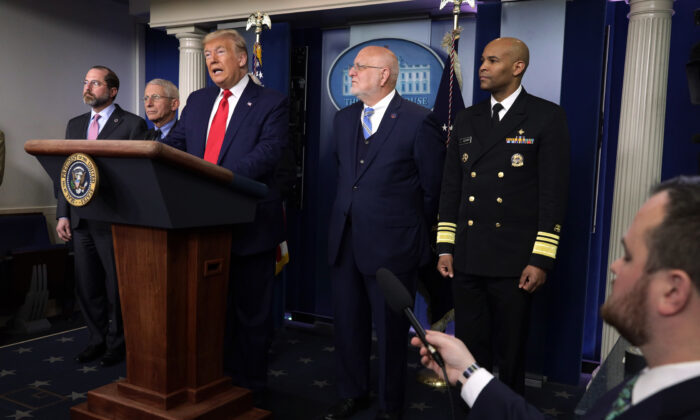
"If we just social distance, we will see this virus and this outbreak basically decline, decline, decline. And I think that's what you're seeing," Dr. Robert Redfield, Director of the Centers for Disease Control and Prevention, said on Monday.
"I think you're going to see the numbers are, in fact, going to be much less than what would have been predicted by the models."
Comment: Of course they're going to be much less than what was predicted, and it's not going to be because of 'social distancing' and forced lockdowns. But that's how it will be spun, of course.
Models are only as good as their assumptions, Redfield asserted, adding officials still don't know everything about the CCP (Chinese Communist Party) virus, commonly known as novel coronavirus.
"A model should never be used to assume that we have a number," the director said.
He was speaking to AM 1030 KVOI Radio, a station in Arizona.
Surgeon General Dr. Jerome Adams, asked on Tuesday whether the death toll will end up lower than the predicted 100,000 to 240,000 deaths, said "absolutely."
"I feel a lot more optimistic, again, because I'm seeing mitigation work," Adams said during an appearance on ABC's "Good Morning America." "I want the American people to know: There is a light at the end of this tunnel, and we feel confident if we keep doing the right thing for the rest of this month that we can start to slowly reopen in some places."
Social distancing measures have been put in place across the country. The overwhelming majority of Americans are under stay-at-home orders. Authorities have threatened jail time and fines for people caught leaving home on non-essential trips.
Model Updated
A major model relied upon by the White House was updated on Monday to reflect additional data coming in from healthcare systems from multiple states, including New York, the most affected state in the nation. Modelers now predict about 12,000 fewer deaths.
Projected peak hospitalizations, intensive care admissions, ventilator use, and deaths were all down in the model, generated by the University of Washington's Institute for Health Metrics and Evaluation.
Asked if he would lift the federal advisory asking people to stay home except for essential trips, President Donald Trump told reporters Monday night that he wants to try.
"We certainly want to try. We certainly want to see what's going on. We're doing very well," he said, adding that the curve, or the increase in cases that ultimately hits a peak before falling, has become "very flat" in many areas.
Trump extended the guidelines in late March to April 30 based on advice from health experts like Dr. Anthony Fauci, director of the National Institute of Allergy and Infectious Diseases.
Fauci said at the same briefing in Washington that America can't go back to normal in terms of acting like the CCP virus never happened.
"I don't think that's going to happen until we do have a situation where you can completely protect the population. But when we say getting back to normal, we mean something very different from what we're going through right now. Because right now we are in a very intense mitigation. When we get back to normal, we'll go back gradually to the point where we can function as a society," he said.
Fauci has said that until there is a vaccine, some mitigation efforts will need to continue. Vaccines aren't projected to be ready until 2021.
Follow Zachary on Twitter: @zackstieber



Comment: Considering the numbers on every level are being fudged, they'll end the bogus lockdown whenever they damn well please.
See also: